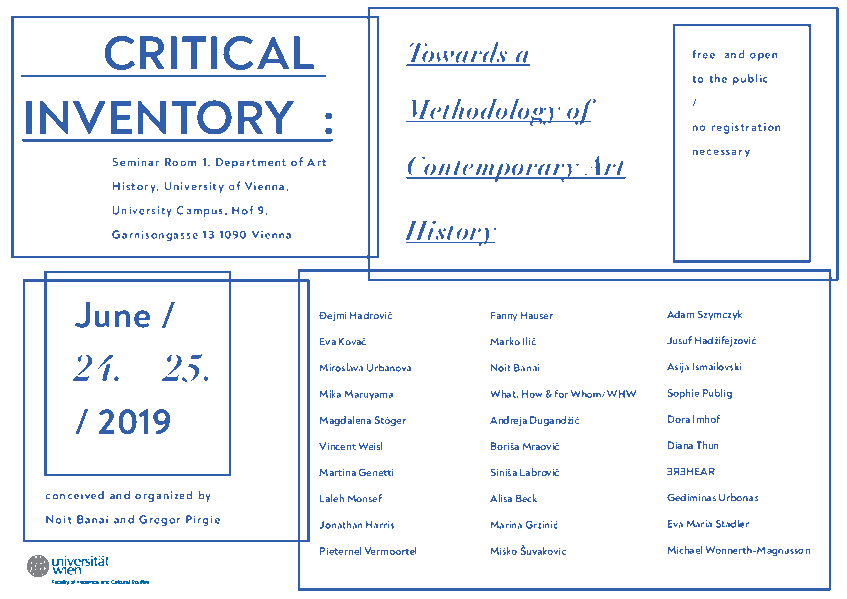Critical Inventory:
Towards a Methodology of Contemporary Art History

© Jennifer Eckert
Date: June 24 – 25, 2019
Location: Seminar Room 1, Department of Art History, University of Vienna
University Campus, Hof 9, Garnisongasse 13 1090 Vienna
Conceptualized and organized by Noit Banai and Gregor Pirgie
https://kunstgeschichte.univie.ac.at/
This international conference emerges from two premises, namely that the writing of Contemporary Art History in a global context is based on developing specific methodologies, theories, and histories that simultaneously continue and disrupt certain genealogies and paradigms emerging from multiple modernisms; and that art historians located in the city of Vienna can play a significant role in this endeavor through their particular positionality. With this double starting point, we wish to focus on the measures through which the multiple histories of contemporary artistic production can be written and consider our own entanglements in their formulation.
To open these pathways, we build upon the five years of dialogue, exchange, and collaboration with diverse protagonists in the field of contemporary art, initiated during Noit Banai’s position as Professor of Contemporary Art at the University of Vienna. Recognizing the importance of connecting theory and praxis, we wish to extend our conversations and analyses with individuals who participated in site visits that occurred in the context of excursions in the city of Vienna and beyond. Between 2014 and 2019, beginning with the imperative to “meet our neighbors,” we consider contemporary artistic practices, forms and techniques of production and reception, and role of institutions in the Austrian region of Vorarlberg and the proximate St. Gallen, extend our foray into Graz, and continue to Ljubljana, Zagreb, Rijeka, Sarajavo, Srebrenica, Banja Luka, Mostar, Novi Sad, Belgrade, and Pristina.
With this this topography as a basis, the following questions lay the foundation for ongoing research and inquiry:
- In the post-1989 context, can we still use the same criteria to assess the multiple histories of contemporary artistic production or do we need to develop new measures and methods and write different art historical narratives? Given the global transformations marked by the fall of the Berlin Wall, the disintegration of Yugoslavia, and the radical reconstitution of the former Eastern bloc, how do we grapple with the need to shape renewed imaginations, practices, and methodologies towards diverse ways of knowing and collective change?
- What models of identity and subjectivity does contemporary artistic production offer and how do these relate to the increasingly powerful structures of neoliberal global capitalism? In this regard, how can we analyze the tensions between ‘local’ and ‘global’ (as well as ‘regional’) as they transform relationships to territory, national culture, notions of community, and forms of labor and give rise to specific artistic practices? What kind of citizens are today’s artistic practices shaping in distinct historical and socioeconomic contexts?
- How does artistic production under conditions of globalization engage with the paradox of simultaneous dematerialization and retrenched materiality? On the one hand, the intensification of media culture, channels of marketing, publicity, and social media that have transformed the world into a ‘global village’ and, on the other, the role of institutions linked to uneven socio-economic conditions that have rendered the world more fragmented and particularized than ever?
- What is the role of specific cities, towns, and regions in shaping and supporting contemporary practices? How do relations between urban centers and rural areas frame the possibilities and limits of artistic and cultural production? What methodologies can we use to historicize both personal and institutional networks of exchange between various metropolises? How do the particular histories, memories, and transformations in the built environment contribute to notions of identity
In the framework of this conference --- “Critical Inventory: Towards a Methodology of Contemporary Art History” -- we wish to revisit these questions in hopes of contributing to our understanding and development of an art historical field that is yet in the making. As the Institut für Kunstgeschichte in Vienna is training the next generation of art historians, many of whom are already active in cultivating the institution of contemporary art in various roles, languages, and countries, we have the unique opportunity to consider our own institutional and pedagogical positionality in articulating a methodology for contemporary art history.
The event is free and open to the public.
